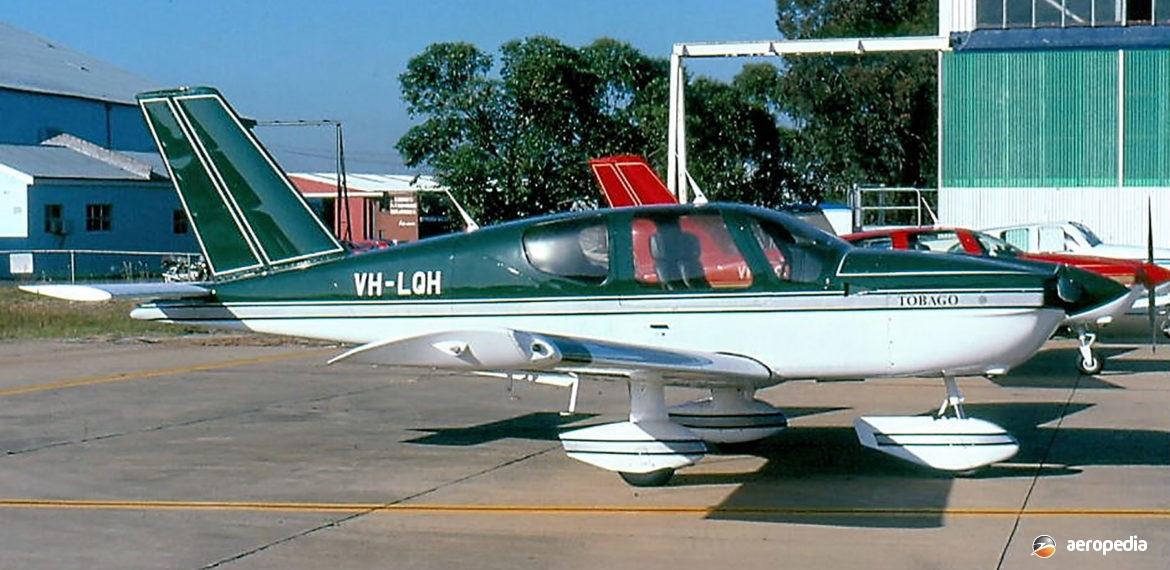Photograph:
Socata TB-10 Tobago VH-LQH (c/n 1117) at Bankstown, NSW in March 1991 (David C Eyre)
Country of origin:
France
Description:
Four-seat cabin monoplane
Power Plant:
One 134 kw (180 hp) Lycoming O-360-A1AD four-cylinder horizontally-opposed air-cooled engine
Specifications:
- Wingspan: 9.76 m (32 ft 0¼ in)
- Length: 7.64 m (25 ft 0¾ in)
- Height: 3.2 m (10 ft 6 in)
- Wing area: 11.9 m² (128.1 sq ft)
- Max speed: 246 km/h (153 mph)
- Max cruising speed at 75% power: 235 km/h (146 mph)
- Economical cruising speed at 65% power: 220 km/h (137 mph)
- Max rate of climb at sea level: 240 m/min (790 ft/min)
- Stalling speed flaps down: 97 km/h (60 mph)
- Service ceiling: 3,960 m (13,000 ft)
- Range with max fuel and 45 mins reserves: 1,074 km (667 miles)
- Empty weight: 670 kg (1,477 lb)
- Loaded weight: 1,150 kg (2,530 lb)
History:
In 1975 the Research and Development Department of the Societe de Construction D’Avions de Tourisme et D’Affaires in France (a subsidiary of Aerospatiale) initiated the design of a new series of touring monoplanes. The prototype, powered by a 119 kw (160 hp) Lycoming O-320-D2A engine, was flown for the first time on 23 February 1977. Known as the TB-10 and registered F-WZJP, this machine was lost during spin testing on 15 December 1977. The second prototype of the TB-10 was powered by a 134 kw (180 hp) Lycoming O-360 engine and, following certification in April 1979, the type entered production.
Two variants were produced, the TB-9 Tampico, a four-seater with a 119 kw (160 hp) Lycoming O-320-D2A engine with a fixed-pitch propeller; and the TB-10 Tobago, a four/five-seater with a 134 kw (180 hp) Lycoming O-360 engine driving a Hartzell constant-speed propeller. A variant of the series known as the TB-11 was built with a 134 kw (180 hp) Lycoming O-360 engine and was designed to perform some aerobatics but this model was not put into production.
The TB-9 Tampico was a fixed undercarriage model and was offered with a choice of a fixed pitch or constant speed propeller, but in 1979 the option was dropped and the Tampico Club model was offered to flying training organizations, being lighter and retaining the 119 kw (160 hp) Lycoming O-320 engine but with a fixed pitch propeller and lower standard of fittings. Two variants of the TB-9 were available, the Tampico FB with a 119 kw (160 hp) Avco Lycoming O-320-D2A engine with a fixed-pitch Sensenich propeller; and the Tampico CS with the same engine but fitted with a Hartzell constant-speed propeller.
The TB-10 continued to be offered with the 134 kw (180 hp) engine but in 1991 a model known as the TB-200 XL with a 149 kw (200 hp) Lycoming IO-360 engine was released. By 1996 some 1,000 examples of the TB-9 and TB-10 series had been delivered. The type has also been operated by a number of air forces, including those of Turkey and Israel. An assembly line was set-up in the United States for the American market.
The first of the series to be seen in Australia was a TB-10-180 imported by the then distributor, H C Sleigh Aviation of Moorabbin, VIC, in February 1981, becoming VH-TBA (c/n 18 – ex F-GBHH) in 1981 and being demonstrated in the eastern states by the manufacturer’s chief test pilot. More than 70 TB-10s and some five TB-9s have been registered in Australasia, and examples of both models have appeared on the New Zealand register.
The type has been very popular with pilot training organizations. The Australian Flying Training School had a fleet of 10; the BAe Ansett Flying College at Tamworth, later known as BAe Systems Flight Training (Australia), at one stage had a fleet of 24 (VH-YTA to VH-YTX) at its Tamworth base; the Australian Aviation College at Salisbury, SA had a fleet of nine (VH-XYB to VH-XYJ); and the Australian Aviation College at Parafield,SA had a fleet of 26 TB-10s. A number of overseas training organizations also operated the TB-9 and TB-10. The Italian Aero Club had 110 TB-9s, and the Indonesian Civil Aviation Academy had 23 TB-10s.

